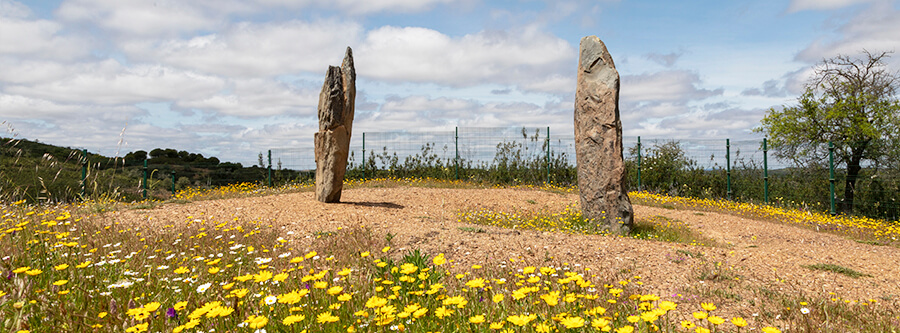Lavajo Menhirs
The Lavajo Menhirs are located about 1.5 km north-east of the village of Afonso Vicente, on top of a small hill at an altitude of 155 m in the civil parish of Alcoutim. In 1992, the first and biggest of the Lavajo Menhirs was identified by António do Nascimento, João Luís Cardoso and Mário Varela Gomes. It is a monolith carved from a block of greywacke; it is dark grey in colour with the appearance of a stele, ellipsoid in section and 3.14 m in height. It bears rich and varied decoration combining elements such as the characteristic dimples arranged along a longitudinal groove with circles and other elements.
Six years later, in 1998, during the first scientific excavation work directed by the archaeologist João Luís Cardoso, four large fragments belonging to two further menhirs were identified, as well as their respective original cavities. Three of the fragments that were found allowed one menhir to be partially reconstituted, and the fourth fragment belonged to a third menhir. These facts underlie the hypothesis that this could have been a line of menhirs. Chronologically, everything indicates that these menhirs were most probably erected during the second half of the fourth millennium B.C. (3,500 B.C.), in a cultural phase that formed part of the Neolithic in what is now Portugal.
With the results of the archaeological research, the “Project for the Recovery and Appreciation of the Lavajo I Menhirs” was drawn up by the local authority; the project included the restoration of one of the menhirs, replacing two menhirs vertically in their original cavities, and the transfer of a menhir fragment to the Archaeology Museum Centre, where it is now exhibited. In order to make it possible to visit the site, a car park and a circuit for visitors were created, and an information panel was erected. A fence was also erected around the respective monuments for protection purposes. The Lavajo Menhirs Archaeological Site was opened on 25th April 2004.
The site complements a visit to the Archaeology Museum Centre and it can be accessed and visited freely, but guided tours can also be arranged by submitting a request to the municipality in advance.
